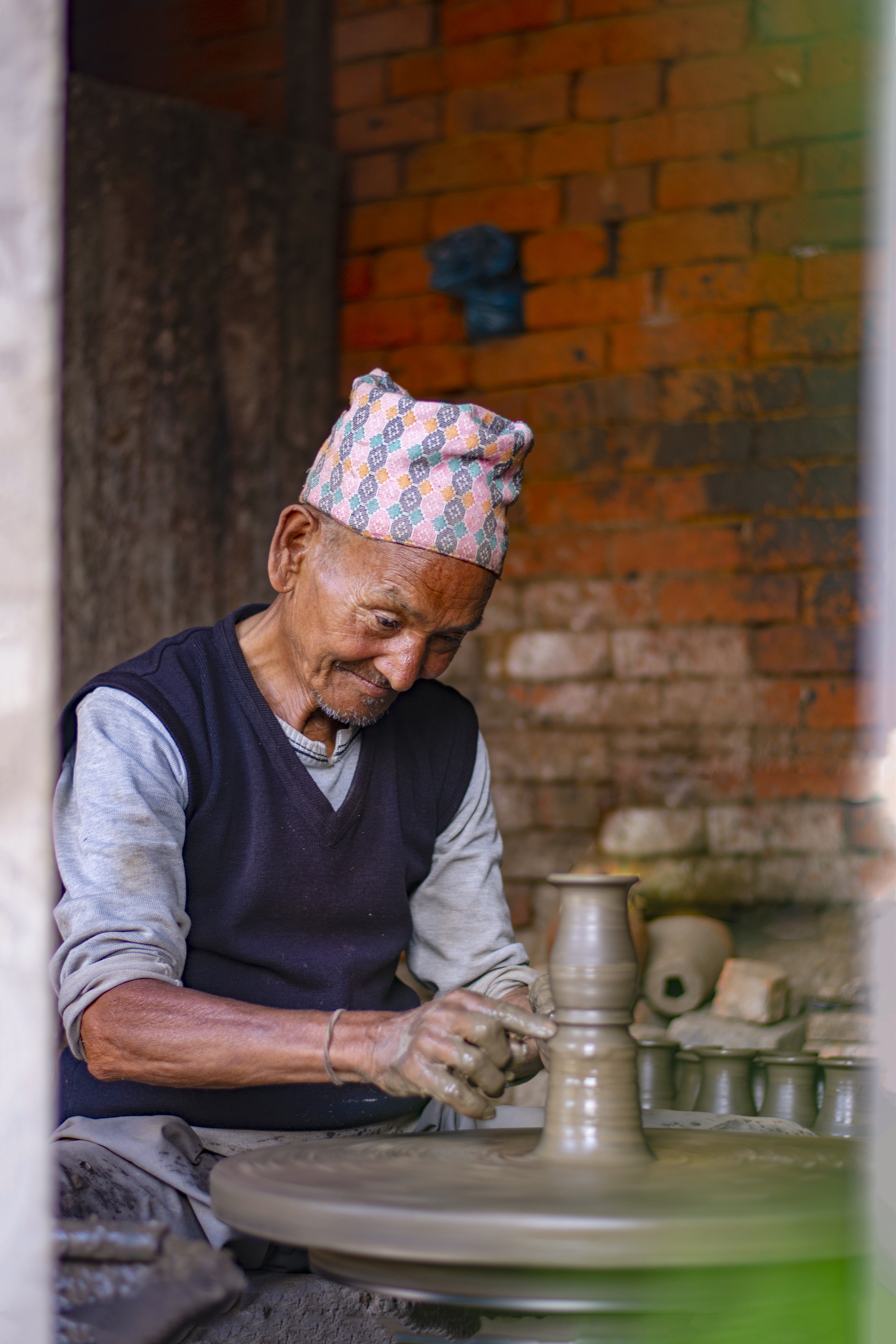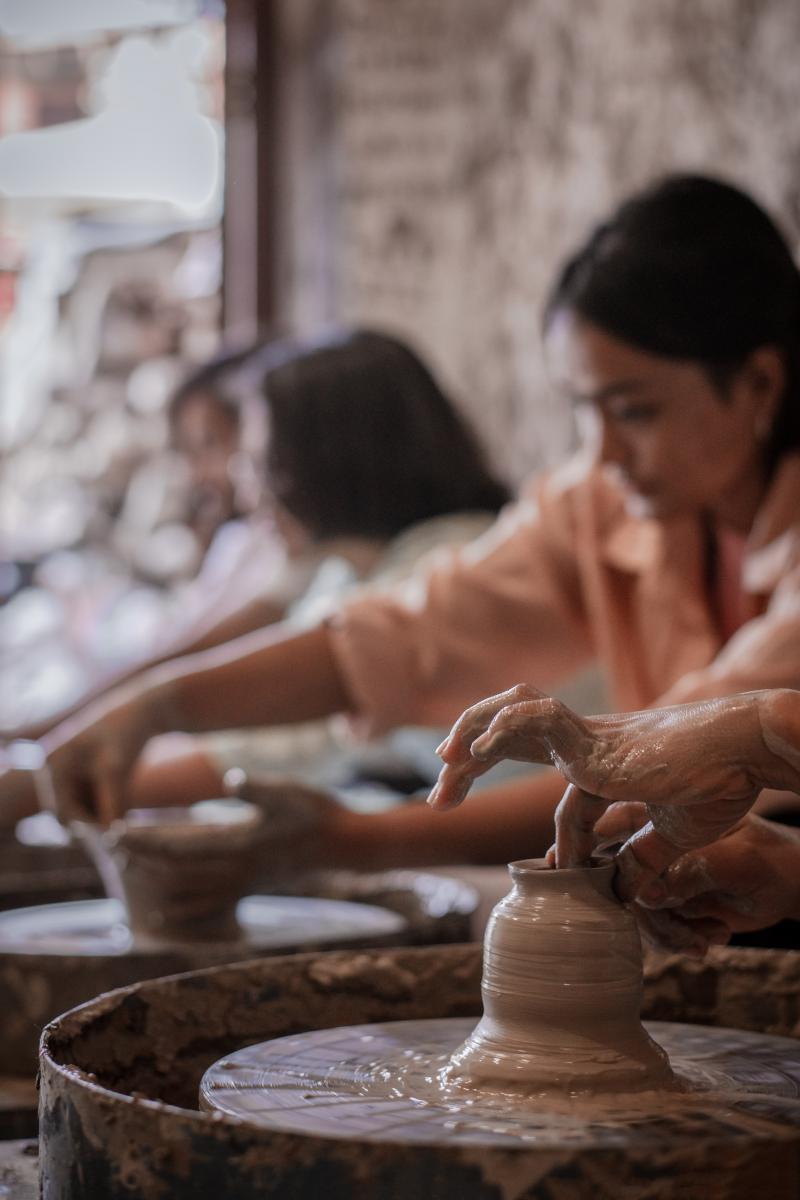Wheel of Warmth: Hands in Clay, Heart at Ease
From ancient wheels in Bhaktapur to modern studios in Kathmandu, pottery is being rediscovered as a way to heal, connect, and create. This story explores how clay is shaping hearts and homes in a fast-paced world.

In Conversation with Ranjana Prajapati, 42 years old potter at Pottery Square, Talako Tole, Bhaktapur.
“Pottery has been a way of life for our caste for generations. But it wasn’t until after the pandemic that pottery began to gain popularity as a lifestyle trend. During the lockdown, people felt suffocated and restless. Once restrictions eased, many Nepalese began visiting pottery centers like ours—looking for something hands-on, calming, to refresh their mind after a long slump. Before COVID, only a handful of tourists would come to try their hand at the wheel. Pottery workshops weren’t commercialized then. But with growing awareness—especially fueled by platforms like TikTok—pottery has now become a must-try experience, and training sessions have turned into thriving businesses.
My father-in-law was deeply involved in this craft. After his passing, and during the lockdown, I learned pottery by myself. It now keeps me occupied and is also a way to earn. My husband is skilled too, and even our son has picked it up, she adds.
Today, fully commercial pottery studios are often set up with aesthetics in mind—Instagrammable interiors, curated corners, and a polished feel to draw in customers. Places like ours, on the other hand, carry layers of dust, stories, and history. But because we’re not as picturesque, we’ve started losing workshop visitors. Still, we remain busy creating traditional clay items like piggy banks, pots, and cups.
What has changed in pottery making over time?
A lot has changed - The quality of clay, for one. In the past, we used to extract clay ourselves - it was pure and plentiful. Now, we have to buy it, and not only is it more expensive, but the quality isn’t as authentic as it used to be. The tools have changed too. The traditional wheels were manual and required more effort, but now most of them are powered by motors, making the process less labor-intensive. There are even portable wheels that can be easily carried from place to place. Still, I prefer the old traditional wheels - they may be heavier, but they last 30 to 40 years.
In a world that spins ever faster on the axis of screens and schedules, there’s a quiet revolution happening - one that takes us back to earth, to ease, and to soul. It begins not with a swipe or a click, but with a humble handful of clay. Welcome to the world of pottery, where hands shape more than vessels - they shape connection, presence, and memory. Clay, once associated with ancient traditions and museum pieces, is emerging as a symbol of modern living. More than just a return to craft—it’s a return to our ancestral roots and also self-care! More and more, families especially young individuals are reaching for clay, not just to create objects, but to find calm, focus, and connection in a world constantly tugging at their attention. Pottery has moved beyond heritage - it’s now a lifestyle
Why Clay Feels So Right, Right Now?
Everywhere we look, screens dominate our time. Our fingers, once meant for touch and tenderness, now scroll endlessly. Days blur into notifications, and even leisure feels hurried. In that chaos, the simple act of molding clay with bare hands feels like a treat.
It’s no surprise then that pottery has emerged as a form of modern meditation. The wheel demands your presence - your full attention. There is no multitasking here. Just you, the clay, and the quiet rhythm of wheels. The messiness, the slowness, the physicality - it’s all deeply human and after all it’s what this generation’s human require. It’s everything modern life isn’t.
Modern takeover of Clay
A major reason behind the growing popularity of clay among younger generations is its aesthetic charm. Handmade pottery doesn’t just serve a function-it tells a story and adds a beauty. On shelves across Kathmandu, handcrafted mugs with earthy glazes sit next to leafy houseplants. Ceramic bowls with soft, organic curves hold morning oats and evening noodles. The rustic, imperfect textures are no longer seen as flaws-but as character. Minimalist cafés gain momentum by serving in locally crafted clay cups. And newlyweds include handmade clay pieces on their gift registries, choosing slow-made beauty over factory perfection. Clay, with all its humble charm, fits beautifully into modern homes that seek warmth. It adds emotion and soul to the space.
From Kiln to Home – A New way of living
Pottery has moved off the display shelves and into daily life. It’s in the teacups we hold each morning, the dinner plates passed around during family meals, the planters perched on windowsills, and the incense holders lit during quiet evenings.
Modern households are moving away from sterile, mass-produced items in favor of handmade ceramics that bring comfort class and character. These are pieces you feel connected to - objects that invite you to pause and appreciate the little rituals of your day.
There's something deeply satisfying about sipping chiya from a clay mug shaped not by a machine, but by your hands. You begin to cherish not just what you use, but how it came to be. It adds value to your everday living.
Families That Spin Together: Clay as Connection
In many household, pottery has become a weekend/leisure activity. Parents and children gather over clay instead of screens. They laugh over lopsided bowls, cheer for each other’s creations, and find joy in shared creativity as well as failed attempts.
Rising pottery workshops now cater to families, offering weekend sessions that allow every generation to bond without digital distractions. Unlike competitive activities, pottery is slow and forgiving. It invites collaboration and patience. There’s no right or wrong—only discovery.
In these spaces, family members often learn things about one another that daily routines don’t reveal. A quiet father opens up while shaping a vase. A child surprises everyone with her focus. A mother finds joy in painting patterns onto a plate. Along with the clay, pottery session allows us to mold our relationships and be better versions of ourselves to our loved ones!
Small Hands, Big Interactions
If there’s one group that naturally gravitates to clay, it’s children. They love the squish, the swirl, the freedom to create without rules. But beyond fun, working with clay is also incredibly enriching.
Shaping clay helps children strengthen motor skills and hand-eye coordination. It also fosters creativity and problem-solving. More importantly, it teaches patience—something hard to come by in today’s instant-gratification world.
Many schools and learning centers are now incorporating pottery into their programs, seeing firsthand how it helps children focus, express themselves, and build confidence. Parents report calmer evenings after a clay session, and kids beam with pride when showing off their handmade treasures.
Whether it’s a tiny creation, a weird shaped plate, or a very ambitious (and slightly wobbly) cup—these pieces aren’t just adorable. They’re milestones in a child’s journey of learning and feeling.
“We regularly host family, friends, and preschoolers’ workshops where creativity and connection come alive.
During one such family workshop, 5 yr old Ganden made many pottery pieces with his mum and grandmum, three generations creating together. One of his favorite creations was a small Boudhanath Stupa, and he said the hollow part inside “holds the prayers of the people.”
As a trainer, I was quietly touched by his thoughtful words and their special moment.”
-Riya Prajapati, founder of Prajapati Ceramic, Kathmandu’s First Pottery Therapy Studio and now one of the top-rated pottery studios in Nepal.
The Gift of Hands and Heart
In a world drowning in disposable gifts, pottery offers something different - something timeless.
Giving someone a handcrafted piece of pottery is like offering a piece of your time, your thought, your touch. Whether it's a hand-painted incense holder for a newlywed couple or a mug with etched initials for a friend, each piece carries a story and extra love. Handmade ceramics are now becoming popular choices for housewarmings, birthdays, anniversaries, and wedding gifts. Studios across Kathmandu even offer custom sessions where people can make a piece of pottery item themselves. The result may not be perfect, yes-but it’s infused with meaning. A simple way of gift giving could be giving your time over a little chit-chat pottery session!
A Craft Reborn
Pottery has always been a part of Nepali heritage, particularly in Newar culture. The alleys of Bhaktapur, Thimi, have echoed with the clinks of drying clay for centuries. Generations of potters have passed down skills honed over decades. Recently, young kids are taught pottery to keep the ancestral skill alive.
What’s beautiful now is how this ancient wisdom is blending with new energy.
Younger artisans are experimenting with glazes, minimal forms, modern shapes, and new techniques. Old kilns are being paired with online stores. Grandfathers teach their grandchildren how to throw clay, while those grandchildren introduce Instagram to the family business.
It’s not a replacement of the old. It’s a revival. And it’s beautiful to witness.
What was once seen as a dying art is now being reimagined by a new generation—one that values culture, but also wants to create something fresh and meaningful.
Where to Begin: Embracing Clay in Everyday Life
You don’t have to be an artist to bring pottery into your life. You just need an open heart and a curious hand. Here are a few ways to begin your journey:
-
Attend a Workshop: Many studios offer beginner classes that are friendly, fun, and deeply satisfying. It’s a great way to explore something new without pressure.
-
Shop Local Ceramics: Start replacing your daily-use cups, plates, or décor with handmade Nepali ceramics. Every piece supports a local artisan.
-
Create With Your Kids: Buy some air-dry clay and spend an afternoon making coasters, candle stands, or fridge magnets together. Messes welcome.
-
Make It a Family Activity: Join a family-friendly pottery session at a local studio. Make it a monthly ritual.
-
Gift With Intention: This wedding season, give something handcrafted. A clay piece may not sparkle, but it will be remembered.
“Pottery is in my roots, passed down by ancestors who were masters of clay. With their blessings, I created a space where people can heal, express, and grow through the art of pottery. Our GEM approach (Guide, Engage, Motivate), welcomes all ages to experience this timeless craft.”
- Riya Prajapati, founder of Prajapati Ceramic
So, this summer, slow down. Pick up the clay. Feel it between your fingers. Let it remind you of something deeper. Of warmth. Of connection. Of the quiet joy of making something with love.
Because in the end, it’s not just about the cups and plates we shape. It’s about the life we’re shaping along the way.
Clay Makers & Spaces to Explore
If you’re ready to begin your journey into pottery, here are some local gems to visit or support:



